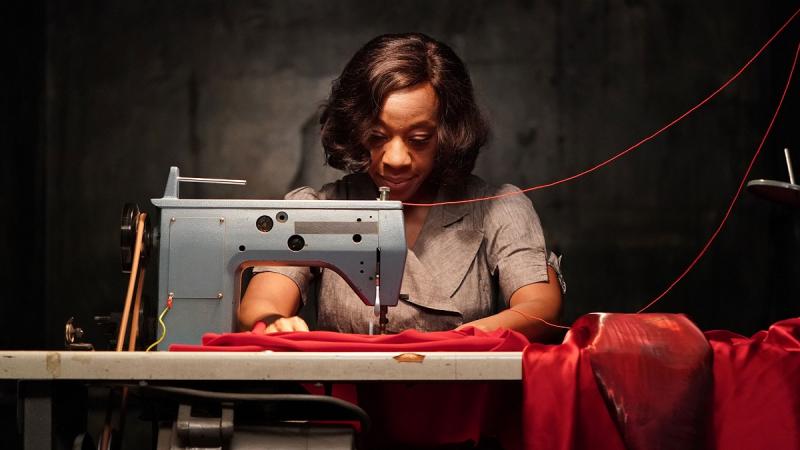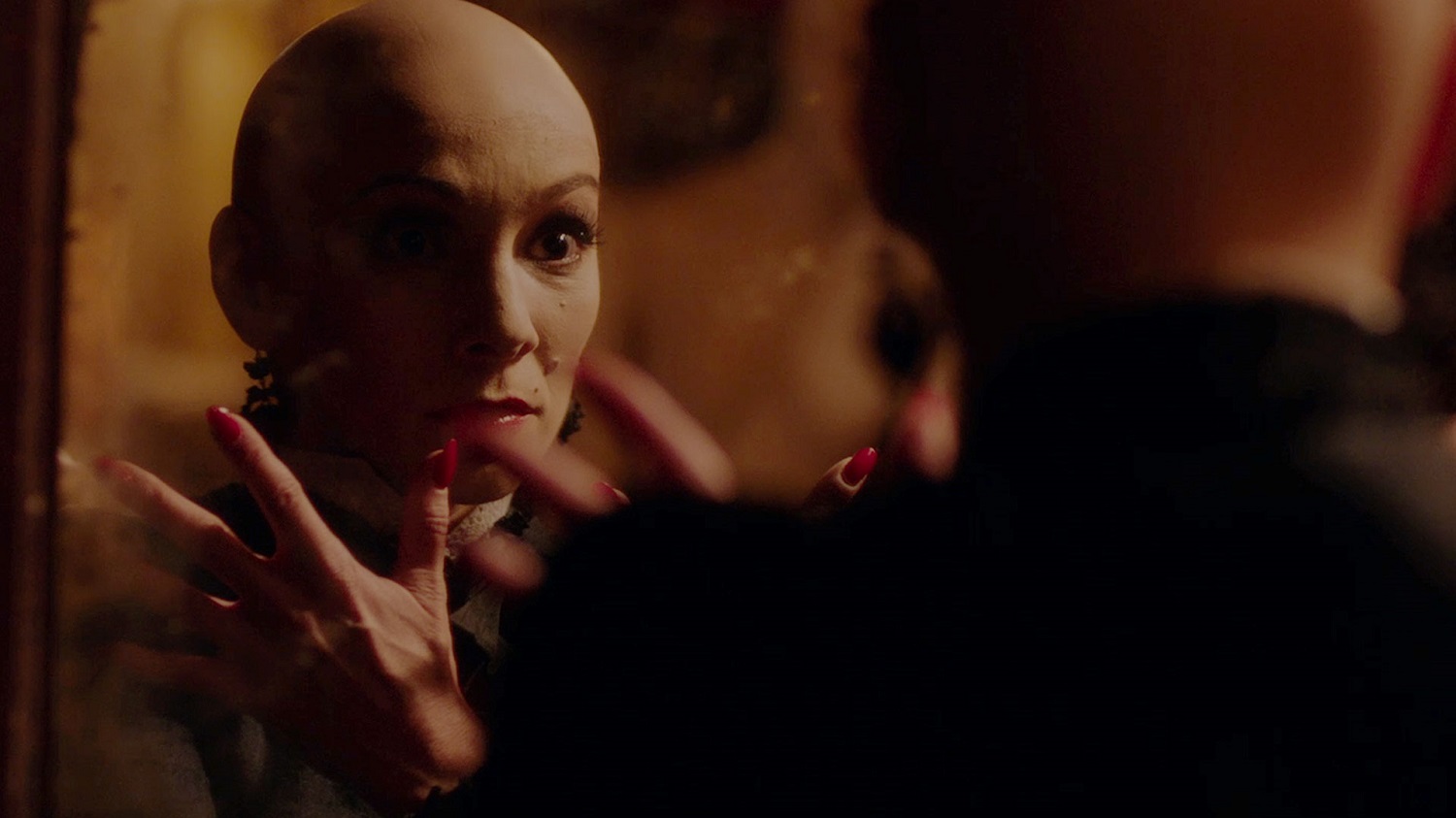In Fabric review - hell is a demonic dress | reviews, news & interviews
In Fabric review - hell is a demonic dress
In Fabric review - hell is a demonic dress
A vengeful red frock takes no prisoners in Peter Strickland's sublime horror comedy

Red is the colour, mayhem is the name – along with pestilence and greed.
Miss Luckmoore, who oversees Sheila’s regrettable purchase, is no ordinary sleek, patronising sales clerk. She’s an Italian or Italianate witch (wonderful Strickland regular Fatma Mohamed, pictured below) whose archaic patter is so convoluted it’s migraine-inducing. When she stays late to sponge the breasts of the shop window mannequin she adores and tastes its menstrual blood (having dipped a finger beneath its abundant black bush), her excited boss Mr. Lundy – who's outside watching through a window – sends globules of semen flying through the cold night air; cinematographer Ari Wegner uses slow motion to poeticise the moment. (As the gaunt, lanky Lundy, Richard Bremmer channels character actor Ernest Thesiger, best known for his ghoulish gents in 1930s horror classics.)

There's an art-for-art's sake quality about Strickland's films and this one in particular. Gorgeous though they are, it's not immediately apparent if they have any deeper purpose, not that it's incumbent on every filmmaker to make social statements. However, the sensuality and compositional perfection of In Fabric doesn't obscure its feeling for ordinary people, their drives and anxieties, or Strickland's recognition that many of us fill the holes in our lives with mindless consumerism or, for whatever psychological reasons, denature sexuality through the use of clothing and objects.
After the malevolent dress has had its way with Sheila, it plays hell with thirtysomething washing-machine repairman Reg Speaks (Leo Bill) – who is forced to wear it at his stag do by his rowdy mates and future father-in-law – and Reg's wedding-obsessed fiancée Babs (Hayley Squires). Like Frodo’s ring, anyone who puts on the elegant off-the-peg number is cursed, though none of Tolkien’s Ringbearers had to deal with a suppurating rash. The dress, which has a mind of its own, eventually passes judgment on the avarice and frenzy of shoppers visiting Dentley and Soper's during the January sales.
As demonstrated by Katalin Varga (2009), Berberian Sound Studio (2012), and The Duke of Burgundy (2014), Strickland delights in tormenting protagonists for whom he clearly feels great tenderness. Jean-Baptiste, as moving here as she was in Mike Leigh’s Secrets & Lies, is endearing as Sheila, a good-hearted, lonely woman negotiating the dating minefield following her marital split. A responsible mum, Sheila tolerates the dismissiveness of her sixth-former son (Jaygann Ayeh) and the contempt of his older live-in girlfriend (Gwendoline Christie). A conscientious employee, Sheila must cope with her hilariously hypercritical supervisors, Stash (Julian Barratt) and Clive (Steve Oram), who have evidently learned from middle-management courses that it’s best to soften up subordinates with bland smiles and praise before attacking them.
The Leigh connection is even stronger in In Fabric’s second half: the torpid Reg and the no-nonsense Babs – precise, humorous studies in working-class manners – could have stepped from such early Eighties Leigh television dramas as Grown-Ups and Home Sweet Home. There are also links to David Lynch via the red silk wraparound dress and signature blue robe worn by Blue Velvet’s Dorothy Vallens (Isabella Rossellini); when Miss Luckmoore removes an item she’s wearing, it’s as shocking as when Dorothy removes the same thing. The title In Fabric echoes "In Dreams," the Roy Orbison song mimed by Dean Stockwell in Blue Velvet.
Though set in 1993 according to the date on a newspaper, In Fabric is steeped in nostalgia for the ambience of 1970s department store shopping, as conveyed through shots of the Dentley and Soper’s TV ads and clothing catalogue and the 19th century dumb waiters and cash railways that survived in some stores at that time. As Strickland casts a loving eye on these artefacts, the nature of fetishism emerges as one of the film’s key themes, not as a symptom of neurosis but as a universal – even democratising – tendency.
Fetishes in In Fabric range from nylon tights (quel horreur!) to the sound of Reg describing, in elaborate mechanical detail, various causes of washing machine failures. As do Stash and Clive when Reg visits them to ask for a loan, Babs goes into a trance listening to Reg’s monotone – a joke at the expense of YouTube ASMR addicts.
Like Berberian Sound Studio especially, In Fabric takes stylistic inspiration from Italian giallo thrillers and horror movies; Mario Bava’s Blood and Black Lace and Dario Argento’s Deep Red were probable touchstones. A woman's flimsy scarlet robe worn in A Virgin Among the Living, directed by Jess Franco, one-man factory of Spanish and French erotic horror pictures, suggests the film influenced In Fabric, as it did The Duke of Burgundy. In Fabric’s playful use of a scary splayed hand motif is a horror trope that goes all the way back to 1922’s Nosferatu. The miracle is that, for all of Strickland’s inspired post-modern pastiching, his films are sui generis in their strangeness and beauty.
rating
Buy
Share this article
The future of Arts Journalism
You can stop theartsdesk.com closing!
We urgently need financing to survive. Our fundraising drive has thus far raised £49,000 but we need to reach £100,000 or we will be forced to close. Please contribute here: https://gofund.me/c3f6033d
And if you can forward this information to anyone who might assist, we’d be grateful.

Subscribe to theartsdesk.com
Thank you for continuing to read our work on theartsdesk.com. For unlimited access to every article in its entirety, including our archive of more than 15,000 pieces, we're asking for £5 per month or £40 per year. We feel it's a very good deal, and hope you do too.
To take a subscription now simply click here.
And if you're looking for that extra gift for a friend or family member, why not treat them to a theartsdesk.com gift subscription?
more Film
 Blu-ray: The Sons of Great Bear
DEFA's first 'Red Western': a revisionist take on colonial expansion
Blu-ray: The Sons of Great Bear
DEFA's first 'Red Western': a revisionist take on colonial expansion
 Spinal Tap II: The End Continues review - comedy rock band fails to revive past glories
Belated satirical sequel runs out of gas
Spinal Tap II: The End Continues review - comedy rock band fails to revive past glories
Belated satirical sequel runs out of gas
 Downton Abbey: The Grand Finale review - an attemptedly elegiac final chapter haunted by its past
Noel Coward is a welcome visitor to the insular world of the hit series
Downton Abbey: The Grand Finale review - an attemptedly elegiac final chapter haunted by its past
Noel Coward is a welcome visitor to the insular world of the hit series
 Islands review - sunshine noir serves an ace
Sam Riley is the holiday resort tennis pro in over his head
Islands review - sunshine noir serves an ace
Sam Riley is the holiday resort tennis pro in over his head
 theartsdesk Q&A: actor Sam Riley on playing a washed-up loner in the thriller 'Islands'
The actor discusses his love of self-destructive characters and the problem with fame
theartsdesk Q&A: actor Sam Riley on playing a washed-up loner in the thriller 'Islands'
The actor discusses his love of self-destructive characters and the problem with fame
 Honey Don’t! review - film noir in the bright sun
A Coen brother with a blood-simple gumshoe caper
Honey Don’t! review - film noir in the bright sun
A Coen brother with a blood-simple gumshoe caper
 The Courageous review - Ophélia Kolb excels as a single mother on the edge
Jasmin Gordon's directorial debut features strong performances but leaves too much unexplained
The Courageous review - Ophélia Kolb excels as a single mother on the edge
Jasmin Gordon's directorial debut features strong performances but leaves too much unexplained
 Blu-ray: The Graduate
Post #MeToo, can Mike Nichols' second feature still lay claim to Classic Film status?
Blu-ray: The Graduate
Post #MeToo, can Mike Nichols' second feature still lay claim to Classic Film status?
 Little Trouble Girls review - masterful debut breathes new life into a girl's sexual awakening
Urska Dukic's study of a confused Catholic teenager is exquisitely realised
Little Trouble Girls review - masterful debut breathes new life into a girl's sexual awakening
Urska Dukic's study of a confused Catholic teenager is exquisitely realised
 Young Mothers review - the Dardennes explore teenage motherhood in compelling drama
Life after birth: five young mothers in Liège struggle to provide for their babies
Young Mothers review - the Dardennes explore teenage motherhood in compelling drama
Life after birth: five young mothers in Liège struggle to provide for their babies
 Blu-ray: Finis Terrae
Bleak but compelling semi-documentary, filmed on location in Brittany
Blu-ray: Finis Terrae
Bleak but compelling semi-documentary, filmed on location in Brittany
 Oslo Stories Trilogy: Sex review - sexual identity slips, hurts and heals
A quietly visionary series concludes with two chimney sweeps' awkward sexual liberation
Oslo Stories Trilogy: Sex review - sexual identity slips, hurts and heals
A quietly visionary series concludes with two chimney sweeps' awkward sexual liberation

Add comment